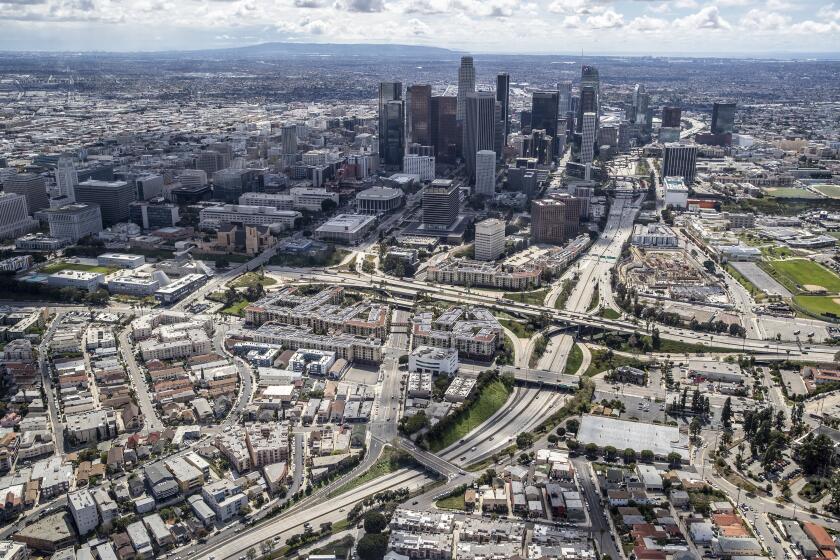Initial earthquake retrofit approved for historic L.A. General Hospital

- Share via
After nearly a century of earthquake vulnerability, the process of retrofitting Los Angeles’ historic General Hospital is finally starting.
The Depression-era facility, which opened in 1933 — an Art Deco icon of the Eastside — ended its tenure as L.A. County’s flagship public medical center in 2008 and was mostly mothballed.
Last year, the county, which owns the former hospital, launched a multi-year program to reconfigure the H-shaped building into homeless and affordable housing. But to do so, officials needed to correct a major vulnerability: The massive structure has been known to be non-ductile concrete, a class of structures vulnerable to collapse in a major earthquake.
Because of that, the Los Angeles County Board of Supervisors on Tuesday approved a project, with an estimated budget of $2 million, to conduct a limited initial seismic retrofit of the decommissioned healthcare facility. The retrofit will improve various columns throughout the basement and first floor of the building, said Kerjon Lee, a spokesperson for the Los Angeles County Department of Public Works.
Work is scheduled to begin in December and be completed around June.
While the initial retrofit is “an effort to improve performance of the building under a seismic event,” Lee said, “the building will still require a more extensive seismic retrofit in the future, which will take several years to design and implement.”
The Board of Supervisors will consider entering an “exclusive negotiation agreement” with a developer at its Nov. 21 meeting. If approved, “the selected developer will consider a more extensive seismic retrofit as part of the overall redevelopment project scope,” Lee said.
Officials have identified 33 buildings owned by Los Angeles County as having a flaw that could cause them to collapse in a major earthquake.
This week’s decision comes months after officials disclosed a list of 33 county-owned concrete buildings determined to be potentially at risk in an earthquake.
Besides the historic Los Angeles County-USC Medical Center, other vulnerable facilities include the downtown Kenneth Hahn Hall of Administration — the heart of county government — as well as two buildings that are home to the Department of Medical Examiner-Coroner in Boyle Heights and the Ferguson Administrative Services Center in Commerce, which is the hub for administrative services for the departments of public health and health services.
Retrofitting designs are already underway for those buildings.
In a milestone for earthquake safety, more than half the 2,000 buildings that Santa Monica deemed as vulnerable have been retrofitted since a historic 2017 city law went into effect.
But there are dozens of other buildings in need of a seismic assessment and retrofit, including the downtown headquarters for the departments of public health and health services; the Pitchess Detention Center East Facility in Castaic; clinics in South L.A., downtown and Hollywood; fire stations in Inglewood and West Hollywood; and libraries in Compton, Huntington Park and Montebello.
Scrutiny of the risk of non-ductile concrete buildings was renewed in February with the catastrophic collapse of many structures of this type in the magnitude 7.8 earthquake that shook Turkey and Syria. More than 50,000 deaths were reported.
That quake — and previous concerns about the risk of concrete buildings — prompted Los Angeles County to set an ambitious 10-year deadline for officials to complete seismic upgrades on both county-owned non-ductile concrete buildings as well as order owners to upgrade any building of this type in the unincorporated area of the county, where 1 million people live.
Non-ductile buildings have an inadequate configuration of steel reinforcing bars, which allows concrete to explode out of columns when shaken in an earthquake, a prelude to a catastrophic collapse. This flaw, now well-known, was discovered in the 1971 Sylmar quake.
The guide to earthquake readiness and resilience that you’ll actually use.
The vast majority of structures on the county’s list were built during the post-World War II boom, when many concrete-frame buildings were erected.
After the 1971 Sylmar quake, non-ductile construction was deemed so unsafe that it was banned a decade later in future buildings.
The cities of Los Angeles, West Hollywood and Santa Monica require non-ductile concrete buildings in the city limits to be retrofitted, with deadlines ranging from 2027 to the 2040s. But most other local governments in California have done little to order older buildings be evaluated and strengthened if found to be deficient.
Forty-nine people died in the 1971 collapse of the non-ductile concrete Veterans Administration hospital in Sylmar, and three were killed when the newly built Olive View Medical Center had buildings and stairways collapse, lurch or topple. A Kaiser Permanente office and clinic and a Bullock’s department store partly collapsed in the 1994 Northridge earthquake.
The same type of non-ductile flaw also led to the collapse of freeways in the Sylmar and Northridge earthquakes and in the 1989 Loma Prieta quake in the San Francisco Bay Area.
More to Read
Sign up for Essential California
The most important California stories and recommendations in your inbox every morning.
You may occasionally receive promotional content from the Los Angeles Times.

















